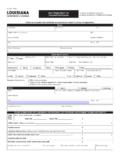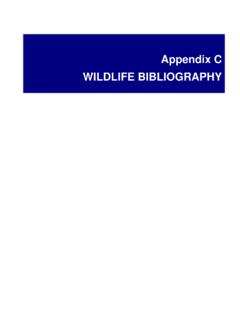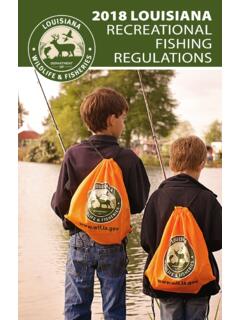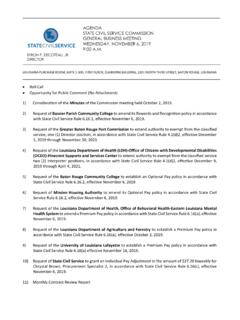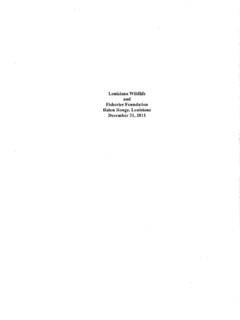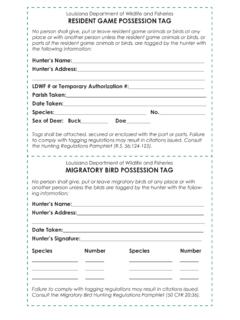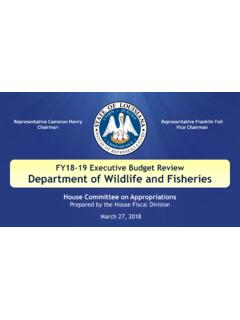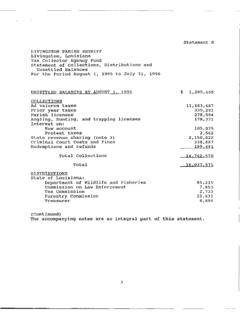Transcription of A Coastal User’s Guide - Louisiana
1 A Coastal user s Guide to the Louisiana Coastal Resources Program A Coastal user s Guide to the Louisiana Coastal Resources Program This document was revised by: The Louisiana department of Natural Resources Office of Coastal Management P. O. Box 44487 Baton Rouge, Louisiana 70804-4487 1-800-267-4019 Revised January 2015 TABLE OF CONTENTS I. PURPOSE OF THIS MANUAL II. INTRODUCTION THE Coastal ZONE LAND LOSS Louisiana Coastal RESOURCES PROGRAM Coastal MANAGEMENT PROGRAMS III. PROGRAM BOUNDARY INTRODUCTION Louisiana Coastal ZONE BOUNDARIES EXCLUDED FEDERAL LANDS IV. PROGRAM GUIDELINES V. APPLYING FOR A Coastal USE PERMIT THE APPLICATION PROCESS Coastal USE PERMIT FEES APPLICATION FEE PERMIT PROCESSING FEE MITIGATION FEE APPLICATION CHECKLIST VI. RULES AND PROCEDURES FOR Coastal USE PERMITS VII.
2 LOCAL Coastal PROGRAMS VIII. FEDERAL Coastal ZONE MANAGEMENT CONSISTENCY APPEAL PROCEDURES IX. SPECIAL AREAS X. PUBLIC HEARINGS XI. APPENDICES A. CHAPTER 7, TITLE 43 - Coastal MANAGEMENT REGULATIONS B. SUBPART C - Louisiana Coastal RESOURCES PROGRAM LEGISLATION C. SAMPLE FORMS PURPOSE OF THIS MANUAL I - 1 PURPOSE The purpose of this manual is to provide an updated document which reflects the changes in legislation and regulations, and to provide essential information needed by the public concerning the Louisiana Coastal Resources Program. This manual does not replace the original Louisiana Coastal Resources Program Final Environmental Impact Statement (FEIS) which is the official program document for Federal approval pursuant to the Coastal Zone Management Act.
3 This manual provides concise and up-to-date information on how to apply for a Coastal use permit and for projects on federally excluded lands and in the Outer Continental Shelf (OCS), consistency authorization. There is also information included concerning local (parish) programs. The first ten sections of the manual are descriptive in nature. They are followed in the Appendices by the complete regulations and requirements of the Louisiana State and Local Coastal Resources Management Act of 1978, as amended, as well as various forms needed in the application process. As the designated lead agency for the Coastal Resources Program, the Louisiana department of Natural Resources has compiled this information for public use and understanding of the program it is responsible for administering.
4 As the program develops or as legislation changes, amendments to this document will be made by the Office of Coastal Management. If there are any questions regarding the information contained in this manual they may be addressed in writing to the Office of Coastal Management, department of Natural Resources, Box 44487, Baton Rouge, LA 70804-4487 or by calling 1-800-267-4019. Additional information can be found on the Office of Coastal Management s web address at INTRODUCTION STATE OF Louisiana department OF NATURAL RESOURCES OFFICE OF Coastal MANAGEMENT Governor Bobby Jindal Secretary Stephen Chustz Assistant Secretary Keith Lovell Administrator Karl L. Morgan, Permits, Mitigation & Support Acting Administrator Don Haydel, Interagency Affairs and Field Services INTRODUCTION Louisiana has 15,000 miles of winding shoreline that extends from the Pearl River westward to the Sabine River.
5 The delicate Coastal zone habitats, located in twenty southern parishes, are an intricate inter-weaving of ecological systems. Renewable Coastal resources include numerous species of wildlife , waterfowl, and wetlands that support highly productive fisheries and fur industries. Non-renewable resources are abundant, with crude oil, natural gas, sulfur, and salt being most common. Covering million acres, the Louisiana Coastal Zone includes large open bays and lakes, barrier islands, cheniers, and natural levee forests. The marshes, swamps, and bottomland hardwoods that sprawl inland from the Gulf of Mexico comprise 41 percent of the continental Coastal wetlands. Almost one-third of Louisiana s people live in the Coastal area. For ecological, economic, and recreational reasons, this vast ecosystem is priceless. If lost, it cannot be replaced.
6 THE Coastal ZONE Because the Coastal Zone is ecologically and economically among the world s richest estuarine regions, it is of vital public interest. The magnitude of the value of the Coastal zone and the significance of sound public policies and management are underscored by the following facts: - Louisiana has 5,000 miles of navigable waterways and a 19,000-mile inland waterway system, most of which is in the Coastal zone. - Louisiana ranks second in the nation in energy production. - Shrimp and oysters are more plentiful in Louisiana waters than in any other Coastal area. - Freshwater fisheries production in Louisiana is the nation s number one catch in value and poundage. - More than a million pelts, including nutria, muskrat, beaver, mink, and otter, are usually taken each season in the Coastal zone. - Louisiana Coastal marshes are North America s largest wintering ground for migratory waterfowl.
7 - Coastal crops of rice, sugarcane, and soybeans annually are valued in the hundreds of millions of dollars. Louisiana s oil and natural gas industries are important to the state s economy, providing taxes and jobs. Proven reserves of both resources are ranked among the nation s largest. Most oil and gas production activity occurs in south Louisiana and offshore in state and federal waters of the Gulf of Mexico. Louisiana s Coastal zone holds abundant reserves of crude oil and natural gas and is a region of major exploration, production and refining activity. Louisiana citizens benefit greatly from Coastal resources. Benefits begin with the natural cycles of the wetlands, which renew wildlife habitats, nourish the food chain that supports fisheries and fur industries, build new wetlands and barrier islands to protect the coast from storms, and provide lakes, bays, and bayous for sport fishing, boating, and waterborne transportation.
8 II-2 Land Loss Louisiana s wetlands are being lost at a rate of approximately 25-35 square miles a year. Nationwide, more than 100 million acres, one-half of all wetlands, have been converted to open water or other habitats since colonial times. In Louisiana , wetlands are lost naturally through compaction and sinking, saltwater intrusion that kills vegetation, hurricane and storm damage, wind and wave erosion, lack of sedimentation, and other processes. Man-induced losses occur from dredging and spoil disposal, draining and filling of lands, levee building, canal digging, mineral extraction, agricultural practices, and industrial and urban expansion. Louisiana Coastal Resources Program The Office of Coastal Management (OCM) of the Louisiana department of Natural Resources is charged with implementing the Louisiana Coastal Resources Program (LCRP) under authority of the Louisiana State and Local Coastal Resources Management Act of 1978, as amended (Act 361, La.)
9 49 et seq). This law seeks to protect, develop, and, where feasible, restore or enhance the resources of the state s Coastal zone. Its broad intent is to encourage multiple uses of resources and adequate economic growth while minimizing adverse effects of one resource use upon another without imposing undue restrictions on any user . Besides striving to balance conservation and resources, the policies of the LCRP also help to resolve user conflicts, encourage Coastal zone recreational values, and determine the future course of Coastal development and conservation. The OCM regulates development activities and manages the resources of the Coastal Zone. A Coastal Use Permit (CUP) Program has been established by the Act to help ensure the management and reasonable use of the state s Coastal wetlands. There are two divisions in the Office of Coastal Management that regulate development activities and manage the resources of the Coastal Zone.
10 These Divisions are Permits & Mitigation and Interagency Affairs / Compliance . The text that follows describes the functions of both divisions and key sections or programs within those divisions that make up the OCM. For complete information on all the various sections and programs of the OCM please visit our webpage at: I. PERMITS/MITIGATION DIVISION A. Permit Section A Coastal Use Permit (CUP) Program has been established by the Act to help ensure the management and reasonable use of the state s Coastal resources and is administered under the Permits, Mitigation & Support Division. The Coastal Use Permit is the basic regulatory tool of the office and is required for certain projects in the Coastal Zone, including but not limited to dredge and fill work, bulkhead construction, shoreline modification, and other development projects such as marinas, subdivisions, drainage facilities and energy infrastructure.
